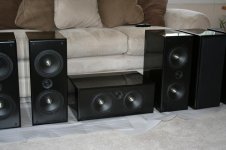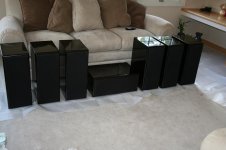Did you paint those with that Hammered spray paint? It looks like it, and I've used it a few times with surprisingly good results. Are you gonna try to fit those with a grill?
Its Duplicolor truck bed coating. Works very well. I have also used the Hammered finish paint in the past, and it also is pretty nice, but its harder to get an even finish with it, and it doesnt cover as well, requiring a fairly well prepped surface.
That's cool. Where do you get that stuff at? I'm not the best wood worker so I am always looking for a new way to finish a speaker in a way that covers my mistakes without endless patching and sanding for a perfectly smooth finish.
to MarkR
earlier in this thread you mention "another forum." You still have yet to reply with that forum's name.
thanks
tony
earlier in this thread you mention "another forum." You still have yet to reply with that forum's name.
thanks
tony
Hello gp4Jesus,
If you look at post #37 in this thread, you will find that MarkR provided a link to the other forum at carstereos.org Ascendant Audio had their official forum there, but have decided not to maintain it.
If you look at post #37 in this thread, you will find that MarkR provided a link to the other forum at carstereos.org Ascendant Audio had their official forum there, but have decided not to maintain it.
Raoul is correct. In fact most of the posts originally in the ascendant audio forum are scattered through out the "general discussion" section. However the thread I linked to I have only been able to find through the link I posted here. Here are a few pics from the 2nd page of the thread.
Attachments
chAse,
How's the other speaker coming along? Do you have them both up and running now?
If so would you care to share your thoughts on them.
How's the other speaker coming along? Do you have them both up and running now?
If so would you care to share your thoughts on them.
So it looks like a sealed MTM or TMM 1 cu foot will work. what the F3?
Anyone want to take a guess on sensitivity for sealed 1 CF VS ported 1.2 CF?
Sensitivity is just as important as size. For me smaller is better?!
Anyone want to take a guess on sensitivity for sealed 1 CF VS ported 1.2 CF?
Sensitivity is just as important as size. For me smaller is better?!
thanks mark
I've since downloaded all the .pdfs; TM & MTM
any takers on my previous post for sensitivity?
again I'm less concerned about F3 as I'm XO'ing them to subs between 80 & 100 hz depending upon Ht decoding logic (THX, DTS, DD, etc
tony
I've since downloaded all the .pdfs; TM & MTM
any takers on my previous post for sensitivity?
again I'm less concerned about F3 as I'm XO'ing them to subs between 80 & 100 hz depending upon Ht decoding logic (THX, DTS, DD, etc
tony
WinISD predicts an F3 of about 80Hz for a dual driver setup in a 1 ft.^3 box, so that should fit your 80Hz crossover just fine. Incidentally, you can reach about an octave deeper by increasing the box size to ~1.8 ft.^3 and adding a vent.
Sensitivity of the two boxes (closed and vented) should remain the same until the point at which they roll off. The sealed box will begin to roll off at a higher frequency, but at a shallower slope.
Sensitivity of the two boxes (closed and vented) should remain the same until the point at which they roll off. The sealed box will begin to roll off at a higher frequency, but at a shallower slope.
and if I've read these posts correctly, sensitivity should be around 91dB for a TMM or MTM with 150 watts handling.
I'll port them to get the sensitivity if needed; I'm XOing them @ 700 or so hertz to a BG 8
I'll port them to get the sensitivity if needed; I'm XOing them @ 700 or so hertz to a BG 8
I’ve modelled this in Unibox, vs the Peerless XLS 12 (830500), often considered better/ best vale for sub sound quality. Can be used up to 300 Hz with a 4the order.
The XLS www.partsexpress.com/pe/showdetl.cfm?&DID=7&Partnumber=297-608 is $160, nearly twice the diameter (3.3 times the Sd), similar Xmax about 3.6 times the volume displaced. Also 3.3 times the Force factor.
The Ascendant has 1/ 84 the Voice coil inductance!
Here are the dB in boxes of two sizes, all with a 0.5 dB peak:
65 Litres:
XLS Ascendant
30 Hz 86 86
50 Hz 86 86
75 Hz 88 88 🙂
25 Litres:
XLS Ascendant
30 Hz 86 79
50 Hz 86 88
75 Hz 88 88 😎
If the Ascendant can equal a dedicated sub in extension, cost only 22% as much, and go more than twice as high in Hz . . what’s the catch??
How is distortion?
😕
The XLS www.partsexpress.com/pe/showdetl.cfm?&DID=7&Partnumber=297-608 is $160, nearly twice the diameter (3.3 times the Sd), similar Xmax about 3.6 times the volume displaced. Also 3.3 times the Force factor.
The Ascendant has 1/ 84 the Voice coil inductance!
Here are the dB in boxes of two sizes, all with a 0.5 dB peak:
65 Litres:
XLS Ascendant
30 Hz 86 86
50 Hz 86 86
75 Hz 88 88 🙂
25 Litres:
XLS Ascendant
30 Hz 86 79
50 Hz 86 88
75 Hz 88 88 😎
If the Ascendant can equal a dedicated sub in extension, cost only 22% as much, and go more than twice as high in Hz . . what’s the catch??
How is distortion?
😕
gp4Jesus said:In series??!! I know that is the case with, say, two 8 ohm drivers in parallel. We're talking about two 4 ohm drivers in series.
The driver impedance is irrelevant. 2 equal drivers in series will be as sensitive, 3dB more efficient (2x the radiating area) (and lower distortion, better power handling) vs. a single driver. 2 in parallel will be 6dB more sensitive, as you get double the radiating area (3dB) and double the current (3dB) but the actual efficiency is only 3dB better.
Doubling the number of drivers, whether series or parallel, will always increase efficiency 3dB. What you change is the tradeoff of impedance for voltage sensitivity. Assuming 8 ohm drivers, series keeps constant voltage sensitivity, but is a 16 ohm load requiring half as much current. Parallel quadruples the voltage sensitivity (6dB), but it takes twice as much current for a given voltage due to the 4 ohm load. In either case you're only 3dB more EFFICIENT as it will take half as much power in either case to achieve the same SPL.
It's amazing how frequently this is misunderstood, given that it's one of the more simple and important aspects of many speaker designs

3.2 ohms - was it designed as a car driver?
With drivers like these, it’s easy to focus on the amazing extension for size, but who knows what is the upper limit of this driver before cone breakup and other “non smoothies”?
Cheers
With drivers like these, it’s easy to focus on the amazing extension for size, but who knows what is the upper limit of this driver before cone breakup and other “non smoothies”?
Cheers
rick57 said:3.2 ohms - was it designed as a car driver?
With drivers like these, it’s easy to focus on the amazing extension for size, but who knows what is the upper limit of this driver before cone breakup and other “non smoothies”?
Cheers
In my situation, breakup happened around 3k. Final xo is at a normal 2.5k.
IMO The top end rumors are false, normal breakup happens. But then smaller drivers lend a hand.
The extension, mid and low end however...
- Status
- Not open for further replies.
- Home
- Loudspeakers
- Multi-Way
- Ascendant 6.5" midrange

